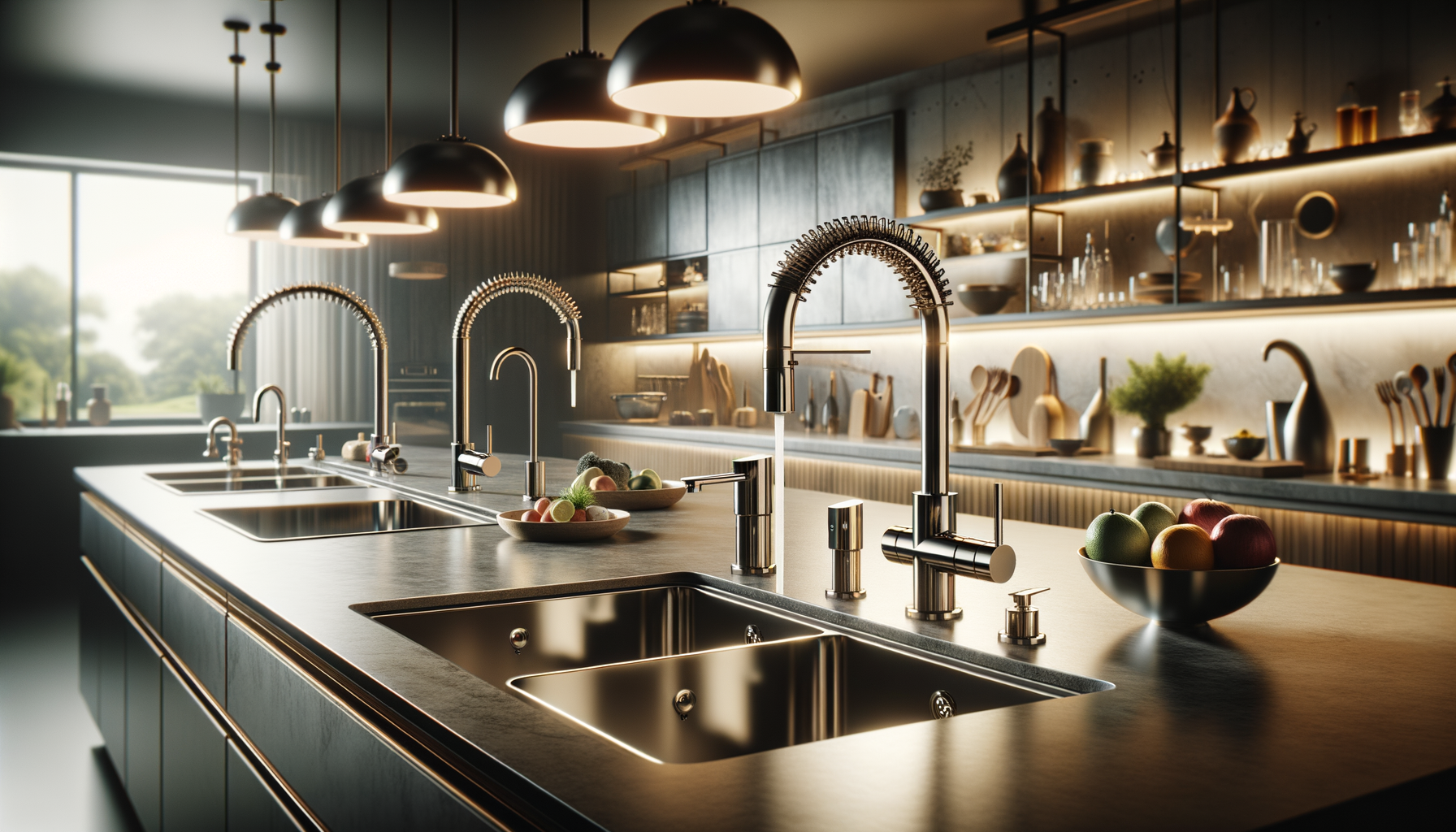Understanding the Importance of Kitchen Sink Faucets
In the heart of every home, the kitchen, the sink faucet plays a pivotal role. It’s not just a tool for dispensing water but a central feature that combines functionality with aesthetics. Kitchen sink faucets have evolved significantly over the years, offering a range of designs and features that cater to diverse needs and preferences. The right faucet can enhance your kitchen’s efficiency, making daily tasks like washing dishes or filling pots a breeze. Moreover, with the advent of modern designs, faucets now contribute to the kitchen’s overall style, complementing the decor and adding a touch of elegance.
Choosing a kitchen faucet involves considering several factors, such as the type of handle, the spout style, and the finish. Each of these elements can impact the faucet’s usability and appearance. For instance, single-handle faucets offer convenience and ease of use, while double-handle ones provide more precise temperature control. Additionally, the spout style, whether high-arc or low-arc, can influence how you use the sink, particularly when dealing with large pots or pans. The finish, be it chrome, stainless steel, or matte black, not only affects the faucet’s look but also its durability and maintenance.
Investing in a high-quality kitchen sink faucet can lead to improved water efficiency, reducing waste and saving on utility bills. Many modern faucets come equipped with features like aerators, which mix air with water to maintain pressure while using less water. This not only benefits the environment but also contributes to cost savings over time. In summary, a well-chosen kitchen sink faucet is a blend of practicality, design, and sustainability, making it a crucial component of any kitchen.
Types of Kitchen Sink Faucets
The variety of kitchen sink faucets available today can be overwhelming, but understanding the different types can help you make an informed decision. Some of the most common types include pull-down, pull-out, single-handle, and dual-handle faucets. Each type offers unique advantages and is suited to specific kitchen setups and user preferences.
Pull-down faucets are renowned for their versatility and ease of use. They feature a spray wand that pulls down directly into the sink, making it ideal for washing dishes and rinsing vegetables. The high-arc design of pull-down faucets provides ample space for filling large pots, making them a popular choice for busy kitchens. On the other hand, pull-out faucets offer similar functionality but with a shorter spout, making them suitable for smaller sinks where space is limited.
Single-handle faucets are favored for their simplicity and ease of temperature control. With just one lever, you can adjust both the water flow and temperature, making them convenient for quick tasks. Dual-handle faucets, however, offer more precise temperature control, as they have separate handles for hot and cold water. This can be particularly beneficial in homes with varying water pressure or temperature needs.
Beyond these basic types, there are also specialty faucets designed for specific functions, such as pot fillers and bar faucets. Pot fillers are typically installed near the stove, allowing you to fill pots directly on the cooktop, which is a great convenience for avid cooks. Bar faucets, smaller in size, are perfect for secondary sinks in wet bars or prep areas. Understanding the different types of kitchen sink faucets can guide you in selecting the one that best fits your needs and enhances your kitchen’s functionality.
Features to Consider When Choosing a Kitchen Sink Faucet
Selecting the right kitchen sink faucet involves more than just choosing a style that matches your kitchen decor. It’s essential to consider features that enhance functionality and convenience. One such feature is the faucet’s spray options. Many modern faucets come with multiple spray settings, such as stream, spray, and pause, allowing you to switch between tasks effortlessly. This versatility can make kitchen chores more efficient and enjoyable.
Another important feature is the faucet’s reach and height. The reach refers to how far the spout extends over the sink, while the height is the vertical distance from the base to the spout’s highest point. These dimensions can affect how you use the faucet, particularly if you have a deep sink or frequently fill large pots. A faucet with a long reach and high arc can provide better access and maneuverability.
Durability and maintenance are also crucial factors to consider. Faucets made from high-quality materials like stainless steel or brass tend to be more durable and resistant to corrosion. Additionally, finishes such as brushed nickel or chrome are not only aesthetically pleasing but also easier to clean and maintain. Some faucets also feature touchless technology, which allows you to activate the water flow with a simple wave of the hand. This can be particularly useful for maintaining hygiene and reducing the spread of germs in the kitchen.
Lastly, consider the installation process and compatibility with your existing sink. Some faucets require multiple holes for installation, while others are designed for single-hole setups. Ensuring that your chosen faucet is compatible with your sink can save time and effort during installation. By considering these features, you can select a kitchen sink faucet that not only meets your functional needs but also enhances your kitchen experience.
Installation and Maintenance Tips for Kitchen Sink Faucets
Installing a kitchen sink faucet may seem daunting, but with the right tools and guidance, it can be a straightforward process. Before starting, gather all necessary tools, such as a basin wrench, plumber’s tape, and adjustable wrench. It’s also important to turn off the water supply to avoid any leaks or spills during installation.
Begin by removing the old faucet, which typically involves loosening the mounting nuts beneath the sink and disconnecting the water supply lines. Once the old faucet is removed, clean the sink surface to ensure a proper seal for the new faucet. If your new faucet requires a different number of holes than your sink currently has, you may need to use a deck plate to cover any unused holes or drill additional ones if necessary.
When installing the new faucet, follow the manufacturer’s instructions carefully. Attach the faucet to the sink, secure it with mounting nuts, and connect the water supply lines. Ensure that all connections are tight to prevent leaks. Once installed, turn on the water supply and check for any leaks. If any are detected, tighten the connections or use plumber’s tape to seal them.
Maintaining your kitchen sink faucet is equally important to ensure its longevity and performance. Regularly clean the faucet with mild soap and water to prevent buildup of grime and mineral deposits. Avoid using abrasive cleaners or scrubbers that can damage the finish. Periodically check the aerator for clogs and clean it to maintain optimal water flow. If your faucet has a pull-out or pull-down spray head, inspect the hose for any signs of wear or leaks and replace it if necessary.
By following these installation and maintenance tips, you can ensure that your kitchen sink faucet remains in excellent condition, providing reliable performance and enhancing your kitchen’s functionality for years to come.
Trends and Innovations in Kitchen Sink Faucets
The world of kitchen sink faucets is continually evolving, with new trends and innovations emerging to meet the demands of modern kitchens. One of the most notable trends is the rise of smart faucets, which integrate technology to offer enhanced convenience and efficiency. These faucets often feature touchless operation, allowing you to turn the water on or off with a simple wave of your hand. Some smart faucets even offer voice activation, enabling you to control the water flow with voice commands, which can be particularly useful when your hands are full or dirty.
Another trend gaining popularity is the use of eco-friendly materials and technologies. Many manufacturers are now focusing on sustainability by producing faucets made from recycled materials and incorporating water-saving features. These eco-friendly faucets not only reduce water consumption but also contribute to a greener kitchen environment.
In terms of design, there is a growing preference for minimalist and sleek aesthetics. Faucets with clean lines, matte finishes, and simple forms are becoming increasingly popular, as they complement modern kitchen designs and offer a timeless appeal. Additionally, the use of bold colors and unique finishes, such as matte black or brushed gold, is on the rise, allowing homeowners to make a statement with their kitchen faucets.
Innovations in faucet technology are also enhancing functionality. For example, some faucets now come with magnetic docking systems that ensure the spray wand stays securely in place when not in use. Others feature advanced filtration systems that provide clean, filtered water directly from the tap, eliminating the need for separate water filtration devices.
These trends and innovations in kitchen sink faucets reflect the evolving needs and preferences of consumers, offering a blend of style, functionality, and sustainability. Whether you’re renovating your kitchen or simply looking to upgrade your faucet, staying informed about these trends can help you make a choice that enhances both your kitchen’s performance and aesthetic appeal.








